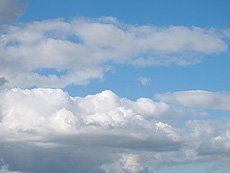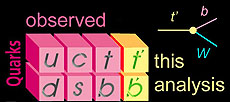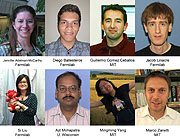|
Have a safe day!
Friday, May 25
3:30 p.m.
DIRECTOR'S COFFEE BREAK - 2nd Flr X-Over
4 p.m.
Joint Experiment-Theoretical Physics Seminar - One West
Speaker: Jonathan Feng, University of California, Irvine
Title: Naturalness and the Status of SUSY
Monday, May 28
HOLIDAY - MEMORIAL DAY
Tuesday, May 29
Noon
Undergraduate Lecture Series - One West
Speaker: Vladimir Shiltsev, Fermilab
Tite: Introduction to accelerators
3:30 p.m.
DIRECTOR'S COFFEE BREAK - 2nd Flr X-Over
THERE WILL BE NO ACCELERATOR PHYSICS AND TECHNOLOGY SEMINAR TODAY
Click here for NALCAL,
a weekly calendar with links to additional information.
Upcoming conferences |
Friday, May 25
- Breakfast: Chorizo burrito
- Smart cuisine: chunky vegetable soup w/ orzo
- Buffalo chicken wings
- Herb garlic tilapia
- Smart cuisine: teriyaki pork stir-fry
- Honey mustard ham & Swiss panini
- Assorted sliced pizza
- Smart cuisine: carved turkey
Wilson Hall Cafe Menu
|
|
Friday, May 25
Dinner
- Romaine & watercress salad w/ Roquefort buttermilk dressing
- Grilled marinated London broil
- Yellow bell pepper orzo gratin
- Roasted zucchini & red onion
- Minted berry sponge cakes
Wednesday, May 30
Lunch
- Andouille & chicken creole pasta
- Mixed greens
- Banana cream pie
Chez Leon Menu
Call x3524 to make your reservation.
|
|
June wellness offerings, fitness classes and employee discounts
Village Pool opens June 5
The Fermilab pool will be open this year from June 5 to August 26. Pool memberships are sold in the Wellness Office on the 15th floor of Wilson Hall.
Pool hours are:
- Tuesday to Friday, noon to 7 p.m.
- Saturday and Sunday, 1 to 6 p.m.
- Monday - closed
Swim lessons are available for preschool children, youths and adults. Water aerobics will take place from noon to 12:45 p.m. on Mondays from June 18 through Aug. 6. For more information, click here.
Fitness classes:
- Butts & Guts meets
Thursdays, June 21 to Aug. 9, from noon to 12:45 p.m. in the Fitness Center.
$53 per person.
- Kyuki-do martial arts class meets Mondays and Wednesdays, June 25 to Aug. 1, from
5 to 6 p.m. in the Fitness Center.
$55 per person.
- Yoga class meets Tuesdays, July 3 to Aug. 21, from noon to 1 p.m. in Ramsey Auditorium. $85 per person.
Featured employee discounts:
- Pockets
- Journey Cycle and BMX
For more information email Jeanne Koester in the Wellness Office at jkoester@fnal.gov.
|
What is the meaning of SaaS?
 |
Cloud computing is a model for enabling remote, on-demand access to a shared pool of configurable computing resources. It comprises three service models: SaaS, PaaS and IaaS. |
Editor's note: On May 8, Fermilab Today ran "Fermilab explores SaaS," a blog post that originally appeared on the website "SaaS in the Enterprise." Fermilab Today readers wrote to ask the meaning of the acronym SaaS. A Fermilab visiting graduate student explains:
Software as a service (SaaS), platform as a service (PaaS) and infrastructure as a service (IaaS) are general terms used to describe the spectrum of internet services that companies and organizations can provide. These services are usually described as being in the "cloud" as they run remotely on the organization's resources rather than the user's computer. The spectrum ranges from IaaS to SaaS, with PaaS being somewhere in between the two. All of these terms are well defined by the National Institute of Standards and Technology document on cloud computing.
IaaS is the most basic of the spectrum of acronyms. In this service, the user rents computing resources such as processing power, storage space and networking using an interface such as a web browser. The user is able to configure the hardware and deploy and operate arbitrary software on these resources. Examples of IaaS providers are Amazon EC2 and Rackspace.
In PaaS, the user is provided with interfaces, programming languages, or other tools by the provider. The user has no control of the configuration of the underlying hardware supporting the application. Examples of PaaS are Google App Engine, Microsoft Azure and the Open Science Grid.
SaaS uses a provider's software directly – the software runs entirely on the provider's computers rather than the user's. The user has no control of the underlying hardware or application. Examples of SaaS are Google Mail, Microsoft Office 365, and Fermilab's FTL provided by Kronos.
—Derek Weitzel, University of Nebraska Holland Computing Center
|
Gran Sasso: Chamber of physics
From Nature, May 23, 2012
The world's largest underground laboratory has been a success story for Italian science. But 30 years after construction began, its future is uncertain.
The drive along Italy's highway A24 from the central Adriatic coast towards Rome begins with a winding climb into the snow-covered Apennine Mountains, followed by a plunge into the 10-kilometer-long tunnel under Gran Sasso, the highest peak in the region. About half way through the tunnel, a detour leads off to the right. It reaches a dead end almost immediately at a heavy iron gate. But press the intercom button and utter the words 'particle physicist' into the microphone, and the gate slides open like something from a James Bond movie.
Not far beyond the gate is a car park. From there one continues on foot, and begins to get some idea of the scale of the infrastructure hidden beneath the mountain. Opening off a long corridor are three huge halls, each about 20 meters wide, 18 meters high and 100 meters long. This vast area is the home of the Gran Sasso National Laboratory, part of the Italian National Institute of Nuclear Physics (INFN).
Read more
|
|
Searching for the next generation
 |
While three generations of quarks have been observed, it is possible that more are to be found. If so, it will take the high-energy collisions of the LHC to find them. |
The ordinary meaning of a generation is an age group in a family. For instance, a child, parent and grandparent come from three different generations. However, in particle physics, the meaning is different. The Standard Model tells us that matter is made of subatomic particles called leptons and quarks. The up and down quarks, combined with the electron and electron neutrino, make up ordinary matter. We say that these particles form a generation. However, physicists have discovered two additional generations of matter. These additional generations are carbon copies of the original one, but with particles that are heavier and unstable. Restricting ourselves to the quarks, the second generation contains the charm and strange quarks, while the third generation consists of the top and bottom quarks.
Measurements at CERN's former Large Electron-Positron collider suggested that there might be exactly three generations, no more and no less. This is a very peculiar state of affairs. Why three? Why not two? Or four? Or more?
To be more specific, what they really showed was that there were three light neutrinos. Since each generation seems to include a light neutrino, that might mean there are just three generations. That gives the universe a little wiggle room. Maybe there is a fourth neutrino that happens to be heavy. If that were true, then a fourth generation would be possible. Given that the higher-numbered generations are heavier versions of the lower-numbered ones, it's even a reasonable supposition.
One way to be sure is to look directly for particles of a fourth generation. The CMS experiment looked for a fourth-generation version of the top quark, which is provisionally (and unimaginatively) called t′ (t-prime). The fourth-generation cousin of the bottom quark is called the b′. Following suggestions from earlier precision measurements, the experiment assumed that the t′ and b′ quarks were about the same mass. If this is so, then the t′ will decay into a W boson and the familiar third-generation bottom quark. Under these assumptions, CMS showed that either t′ quarks don't exist or that they are more than 550 times heavier than a proton. With the additional data expected to be recorded in 2012, CMS will repeat the analysis, looking for even heavier quarks.
—Don Lincoln
 |
These physicists contributed to this analysis. |
 |
These are the U.S. members of the Computing Operations team that take care of all central workflows, like the production of simulated data sets and data re-reconstruction, and also keep the transfers and the Tier-0 running perfectly. |
|
|